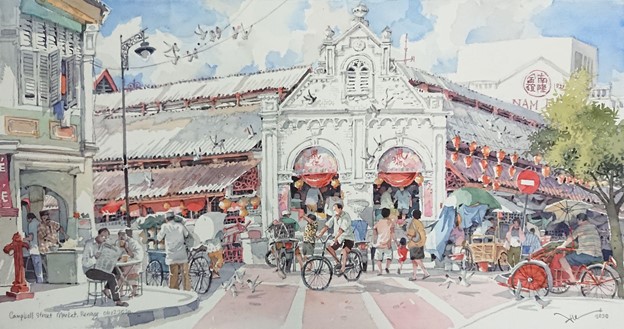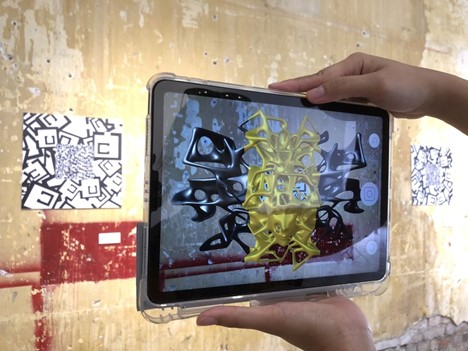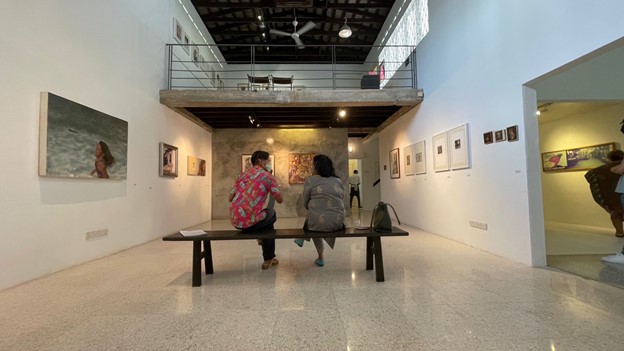Art galleries curate exhibitions to sell and promote artists and their works. Such is an art gallery’s contribution to the art ecosystem. However, in recent years there is an impression that Penang galleries’ representation seems to be reserved for traditional art, leaving no space for the contemporaries.
By Eeyan Chuah
When I bring up the supposed lack of contemporary representation in galleries as a conversation starter, I usually get asked: ‘What do you mean by contemporary art?’ What indeed? Broadly speaking, any form of art produced from the late 20th century (postmodernism) till present day is considered to be contemporary art. In other words, contemporary art means “The Art of Today”.
‘If you are referring to paintings, then yes, I think all galleries do sell contemporaries. The medium might be considered traditional but these are current practicing artists of today hence their works are also considered contemporary,’ explains Tan Ee Lene, gallerist and owner of The Art Gallery in Penang.

Campbell Street Market, Penang. 2020. A watercolour piece by Alex Leong, one of the best-selling artists in The Art Gallery. Photo courtesy of Tan Ee Lene.
‘However if you are referring to artworks that challenge the more traditional notion of art—works that make the viewer question what it is that defines Art—this style of art is not particularly uniform and may be more challenging to represent in a white box gallery,’ states Alvin Chia, curator of Ming Fine Art, Penang. ‘First of all, there are so many forms of contemporary art. There are the sculptures, mixed media installations, photography, digital art, and now the NFTs. To be a gallery that represents them all would be very confusing if not executed carefully. Therefore, in order to sustain as a business, we focus more on the demands of the market in Penang which would be more confined to the traditional form of paintings.’ He further adds, ‘These are what people want when they are in Penang! Somehow, the buyers have decided that the contemporary art scene is more exclusive in KL while Penang retains the nostalgia of traditional art forms.’
A quick investigation would seem to prove Chia right. Ming Fine Art and The Art Gallery are two of the more notable commercial galleries in Penang and they generally do not sell contemporary art besides the more recent interpretations of watercolour and oil paintings, most of which are still life or images of local scenery. Meanwhile, Hin Bus Depot and the gallery at ChinaHouse only represent contemporary, post modernism content, but they both depend heavily on their F&B and retail outlets to sustain the exhibition space.

An augmented reality exhibition held recently in Hin Bus Depot, showcasing digital sculptures created by Aboud Fares. Photo courtesy of Opalyn Mok
I then turn to Lee Khai, a veteran art collector and the chairman of Penang State Art Gallery, and asked which gallery he would go to when he is looking to buy contemporary art (though he prefers the term postmodern art). ‘G13 and Core Gallery,’ states Lee, both longstanding contemporary art galleries in KL. ‘The thing I notice about Penang galleries is that they tend not to spend effort in discovering and nurturing young artists. But then again, it is not the role of commercial galleries to promote contemporary art.’
So, are the galleries in Penang not showcasing any contemporary art because there are no buyers? Or are the contemporary buyers not buying in Penang because the galleries do not represent them?

Local artist Mandy Maung’s solo exhibition ‘Orikata Tales’, curated by Ivan Gabriel at a multi-purpose studio/exhibition space, located at 26, Lorong Carnarvon, George Town, Penang. Photo courtesy of Mandy Maung.
Meanwhile, Penang-based curator Ivan Gabriel believes that most, if not every, artwork can be sold. ‘It is a matter of presenting them to the right market and there is certainly no lack of young contemporary urbanites in Penang,’ says Gabriel. While that is true in Gabriel’s case, it is worthwhile to note that most of his curatorial and art sales experience are not confined within the white box of a commercial gallery. Gabriel is an independent curator who has a wide experience of working with different art and cultural institutions such as Penang State Art Gallery and Peranakan Penang. What that means is that he does not have the pressure of hitting a certain amount of monthly sales in order to sustain an art business.
To gain a broader perspective, I spoke with a curator from KL, Sharmin Parameswaran, to ask what can be done to level the fields between the two cities in the local contemporary art scene. She explains that it is very hard to compare the two because the ecosystem in KL is simply bigger. There are more art schools in KL, more creative industries are based in KL, more art spaces, more buyers in KL. ‘I have been going to Penang to attend art happenings for the past 10 years or so and I notice that the pool of artists and creators seem to stay the same, whereas in KL, there are always new spaces to check out and new artists and collectors to meet.’

Temu House, an art and event space in PJ, KL. Sharmin Parameswaran is a regular collaborator. Image courtesy of Sharmin Parameswaran.
‘So where are the new generation of Penang artists?’ I ask.
‘Maybe that is the problem,’ Sharmin states. ‘That Penang keeps fixating on “Penang” artists. I know some young artists from Penang who are sharing their content either outside of Penang or on social media and they are doing well. Creativity does not need to be confined within one’s locality, and social media has certainly changed the game plan. Over here in KL, the galleries have very active social media accounts to keep up with the artists and buyers globally, which is also something I don’t see in Penang galleries. Maybe it will be good for Penang creatives and galleries to have more national or even international exchanges.’
With that food for thought, I shared what I learned from Sharmin with Gabriel. ‘I hear what she is saying and while I agree with her, I as a curator love working with Penang artists and I think it is important too—to establish a presence of our own,’ says Gabriel. He believes that while Penang galleries might not be as established as KL galleries, there is a healthy contemporary scene growing and that it just takes time for it to fully develop.
As an amateur collector myself, I think I understand what he means. I might not be able to afford commercial gallery prices but I actively visit exhibitions from young contemporaries and I—along with many other collectors like myself—collect within my modest budget. Maybe in time as our earnings grow (here’s hoping!) along with our generation, so will the market for postmodern works in the local galleries. Gabriel agrees as I share my thoughts with him. ‘And by the way,’ he adds, ‘art does not need to be confined within galleries. Most contemporary art in Penang have grown organically out on the streets, in pop ups and in festivals. Maybe that is what makes contemporary art unique in Penang.’
Starting from a somewhat hopeless outlook in the beginning of this conversation, that prospect seems rather promising and I, for one, am all for it!
Eeyan Chuah—from Penang, lives in Penang. Writing is one of her very few skills.

